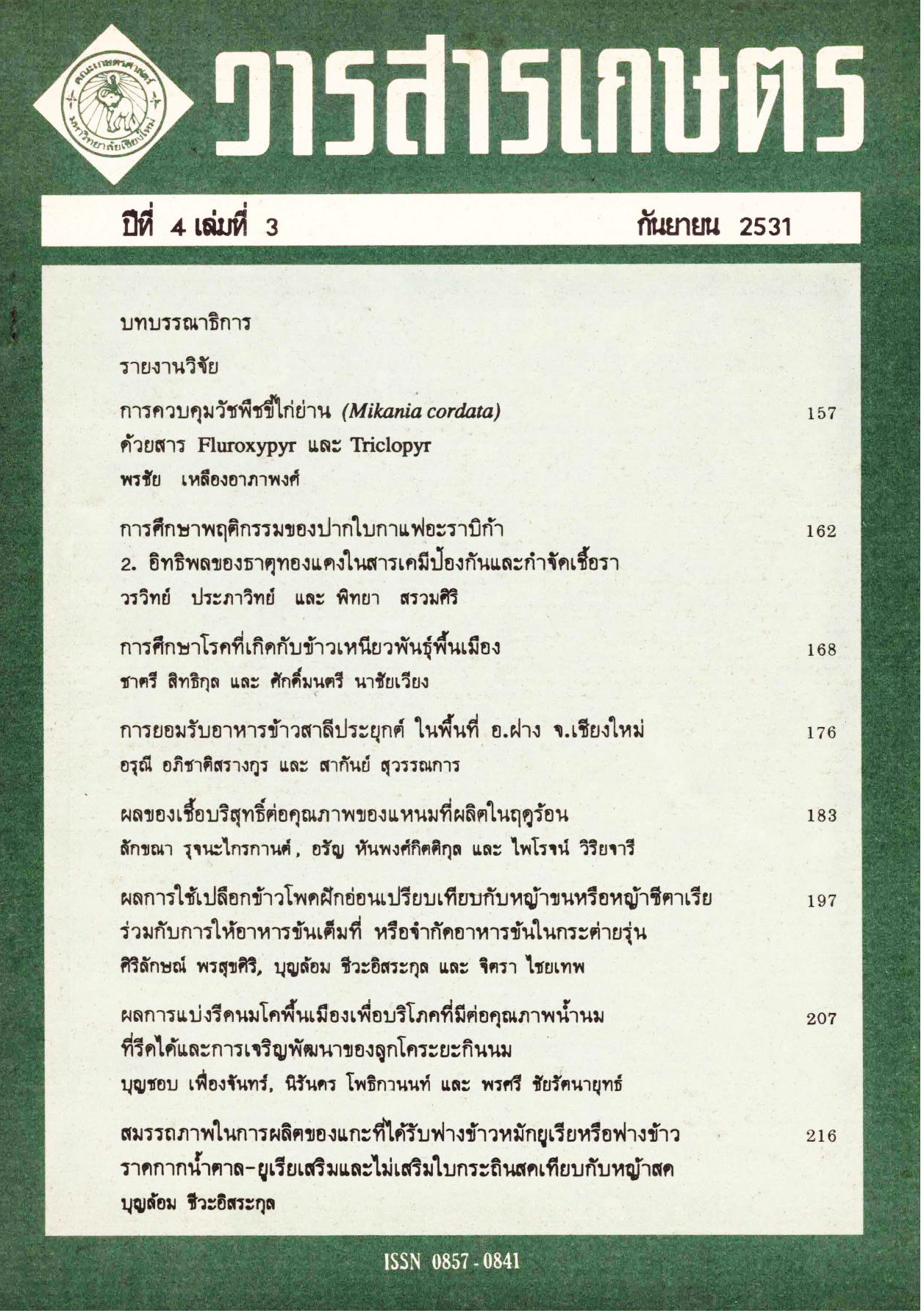PERFORMANCE OF SHEEP FED UREA-TREATED OR UREA-MOLASSES RICE STRAW WITH OR WITHOUT FRESH LEUCAENA SUPPLEMENT AS COMPARED WITH FRESH GRASS
Main Article Content
Abstract
Twenty-five male sheeps of average LW 19.81.8 kg. were allocated in 5 treatements of randomized block design, i.e. fresh para grass (ad lib), 4% urea-treated rice straw (UTS), 2% urea + 10% molases-mixed-straw (UMS) (ad lib),UTS + 1000 g fresh leucaena leaves (LL) and UMS + 1000 g LL. The experimental period lasted 69 days during which digestibility and balance trial of animals fed 5 treatment diets were also carried out. Para grass used contained 23% DM, 15% CP and 66% NDF while LL contained 28,24 and 33% of these nutrients, respeactively. The nutrient content in UTS and UMS were similarly 50% DM,9% CP AND 72% NDF. Sheep fed para grass (T,) gained significantly the highest weight (86g/d, P≤ 0.05) due to higher digestibility of crude protein and consequently, N-retention. DMI was found to be 776.4 g/d (3.4% BW or 74.2g/kg 0.75). There was no significant difference in sheep fed UTS or UMS regardless of LL supplement. DMI of 688 and 744 g/d (3.3 and 3.7% Bw, or 70.1 and 78.6g/kg 0.75) of T2, and T3, respectively, indicated the high palatability of both feed classes. Fair digestibility of nutrients and marginal positive CP-retention of 10.6g/d as well as 38 g ADG indicated that both UTS and UMS could only supply nutrients just above maintenance level. When LL was supplemented to UTS or UMS at 1000 g fresh matter which was equal to 285 g DM (1.3% BW or 35-40% of total DMI), weight gain was significantly improved. Total DMI (g/d) increased although substitution rate was found. No toxic effect at high supplementation of fresh LL was noted.
Article Details
References
กาญจนพฤฒิพงษ์, จีระชัย, และชีวะอิสระกุล, บุญล้อม. (2529), การศึกษาเปรียบเทียบการใช้ ฟางข้าวหมักยูเรียกับฟางข้าวราดสารละลายยูเรีย-กากน้ําตาล เป็นอาหารหยาบสําหรับ วัวนมรุ่นเพศผู้, ประมวิชาการ สาขาสัตวศาสตร์ ครั้งที่ 24 ณ. มหาวิทยาลัยเกษตรศาสตร์ กรุงเทพฯ 27-29 ม. ค 2529.
ชีวะอิสระกุล, บุญล้อม., และ โพธิกานนท์, นิรันดร. (2527), สมรรถภาพในการผลิตของวัวรุ่น เพศผู้ได้รับฟางธรรมดาเสริมด้วยกระถิน เปรียบเทียบกับฟางปรุงแต่งด้วยยูเรียเป็นอาหารฐาน. ประชุมวิชาการ สาขาสัตวศาสตร์ ครั้งที่ 22 ณ. มหาวิทยาลัยเกษตรศาสตร์ กรุงเทพพฯ 30 ม. ค - 3 ก. พ 2527.
ชีวะอิสระกุล, บุญเสริม. และชีวะอิสระกุล, บุญล้อม .(2529), สมรรถภาพในการผลิตของวัวรุ่น ที่ได้รับฟางข้าวเสริมกระถินและเปรียบเทียบกับฟางปรุงแต่งและร. วารสารเกษตร , 2(1): 1 - 16.
วรรณพัฒน์, เมธา., ประเสริฐศักดิ์ , สมโภช., จันทร์ไทย, ศักดิ์สิทธิ์; และศิวะประภากร, อภิชัย(2525). ผลการใช้ฟางหมักยูเรียและมันเส้นที่มีต่อปริมาณอาหารที่กินและการ เปลี่ยนแปลง นน.ของช่วงหน้าแล้ง. ประชุมวิชาการ สาขาสัตวศาสตร์ ครั้งที่ 20 ณ. มหาวิทยาลัยเกษตรศาสตร์ กรุงเทพฯ 1-5 ก.พ 2525.
พรหมา, สมคิด. (2527), การศึกษาการเลี้ยงโคที่กําลังให้นมด้วยฟางข้าวซึ่งได้รับการปรุงแต่งด้วย คุณภาพแล้วเป็นอาหารหลัก. ประชุมวิชาการ สาขาสัตว์ ครั้งที่ 22 ณ. มหาวิทยาลัยเกษตรศาสตร์ กรุงเทพฯ 30 ม. ค - 3 ก. พ 2527.
พรหมา, สมคิด. รัตนวณิช, อภิชาติ., ตุ้ยคําภีร์ , สมเพชร., วิทยากร, นิพนธ์. และสุวภาพ, อรวรรณ. (2525). การทดลองใช้ฟางข้าวซึ่งได้รับการปรุงแต่งคุณภาพแล้วเป็นอาหาร หยาบหลักสําหรับเลี้ยงโคนมรุ่น. ประชุมวิชาการ สาขาสัตวศาสตร์ ครั้งที่ 20 ณ. มหาวิทยาลัยเกษตรศาสตร์ กรุงเทพฯ 1-5 ก.พ 2525.
AGRICULTURAL RESEARCH COUNCIL. (1980). The Nutrient Requirements of Ruminant Livestock. (Commonwelath Agricultural Bureaux, Farnham Royal, England).
BAMUALIM, A. (1985). Effect of leucaena fed as a supplement to ruminants on low quality roughage diets. In "Ruminant Feeding Systems Utilizing Fibrous Agricultural Residues - 1985", p. 107-112, ed R.M. Dixon (School of Agriculture and Forestry, University of Melbourne, Australia).
DEVENDRA, C. (1982). The nutritive value of Leucaena leucocephala cv. Peru in balance growth studies with goats and sheep. Mardi Res. Bull. 10,2: 138 -150.
EGAN, A.R. (1985). Principles of supplementation of poor quality roughage with nitrogen. In
"Ruminant Feeding Systems Utilizing Agricultural Residues - 1985" p. 49-58, ed R. M. Dixon (School of Agriculture and Forestry, University of Melbourne. Australia).
GOERING, H.K. and VAN SOEST, P.J.(1970). Forage Fibre Analyses. U.S. Dept. Agr. Hand book No. 379.
JONES, R.J. (1981). Does ruminal metabolism of mimosine explain the absence of Leucaena toxicity in Hawaii? Aust. Vet. j. 57:55-56.
MORAN, J.B., SATOTO, K.B.and DAWSON, J.E. (1983). The utilization of rice straw fed to zebu cattle and swamp buffalo as influenced by alkali treatment and Leucaena supplementation. Australian Journal of Agricultural Research. 34 : 73-84.
NAUMANN, K. and BASSLER, R. (1976). Methodenbuch band III. Die Chemische Unter suchung von Futter mitteln. Verlag J. Neumann-Neudamm. Melsungen, Federal Republic of Germany.
PEREZ, C.B.(1976). Fattening cattle on farm by-products. ASPAC Food and Rertilizer Technology Centre. Extension Bulletin 83: 1-11.
SAADULAH, M., HAQUE, M. and DOLBERG, F. (1983). Effect of chemical treatment of rice straw supplemented with concentrate on feed intake and weight gain in growing calves. In 'The Utilization of Fibrous Agricultural Residues", pp. 129-139, ed G.R. Pearce (Australian Goverment Publishing Service, Canberra, Australia).
TER MEULEN, U. and EL-HARITH, E.A. (1985). Mimosine - a factor limiting the use of Leucaena leucocephala as an animal feed. Der Tropenlandwirt. 86: 109-127.
WAHYUNI, S., YALIANTI, E.S. KOMARA, W. YATES, N.G. OBST, J.M. and LOWRY, J.B. (1982).The performance of Ongole cattle offered either grass, sun-dried Leucaena Leucocephala or varying proprtions of each. Tropi Animal Production. 7: 275-282.
WONG, C.C. and DEVENDRA, C. (1983). Research on leucaena for-age production in Malaysia. In "Leucaena Research in the Asian-Pacific Region", p. 55. Proceedings of a Workshop held in Singapore, November 1982. IDRC, Ottawa.
WONGSRIKEAO, W. and WANAPAT, M. (1985). A comparison of untreated or urea treated rice straw when supplemented with fresh leucaena for buffaloes. In "Ruminant Feeding Systems Utilizing Fibrous Agricultural Residues-1985", p. 49 58, ed R.M. Dixon (School of Agriculture and Forestry, University of Melbourne, Australia).


